17 mINUTE READ
We all know our small dogs are the most loving, loyal creatures on earth. But do we really understand the unusual ways they show us their love? And how can we communicate our own feelings of affection to them in ways that they’ll truly understand?
There’s so much more to loving our fur kids than just petting and cuddling (not that we’re criticizing that highly rewarding perk of small dog life). But before we look at how to love our dogs, let’s backtrack and consider the fact that some of us aren’t even sure our dogs feel our love at all.
Do Our Dogs Know We Love Them?
Do people actually ask that question?
According to at least one expert (we’ll call her “Google”), yes.
At first, I thought the question made no sense. I mean, of course dogs feel the love and affection we have for them.
Right?
But then, I considered how challenging it is for we humans to get the whole “love” thing right. I mean, how often do we love someone but we’re too busy, too distracted, or too clueless to show them love in the way they need to receive it. And, we have trouble demonstrating our love to other humans, in spite of the fact that we speak the same language!
So, given that we’re separated from our dogs not just by a language barrier, but by a species divide as well, it’s not such a stupid thing to ask does my dog know I love her?
After all, we’re often even more absent or distracted with our dogs than we are with our favorite people, and we certainly don’t speak “dog”.
Thus, instead of asking whether dogs know how much we love them, the question should be how can I make sure my dog knows I love her? And to do that, we’ve got to cross that species divide.
How To Say “I Love You” in Dog Language
 We’ve all seen the Insta-famous dogs who use human-language buttons to communicate pretty complex ideas to their people. (And if you haven’t, you have GOT to check them out). Teaching dogs to speak our language is pretty amazing.
We’ve all seen the Insta-famous dogs who use human-language buttons to communicate pretty complex ideas to their people. (And if you haven’t, you have GOT to check them out). Teaching dogs to speak our language is pretty amazing.
But, it’s also considered highly respectful to learn another culture’s language (unless you’re butchering the French language in France. I hear they get testy about that). In other words, when you visit other countries, it’s viewed as arrogant to assume everyone will bend to your language. Wouldn’t that same concept hold true with our dogs? Perhaps rather than merely teaching dogs our language, it would be more loving to learn some of their “spoken” word and say “I love you” in dog language.
Dr. Wes Arnett at Waunakee Vet Clinic in Wisconsin argues that you can show your dog affection they understand by mirroring the affection they provide to us: holding their gaze, leaning against them, sharing your bed, and even using your eyebrows for expression (apparently a left lift is a good thing! Who knew?).
In our house, Dr. Arnett’s list is pretty well represented in the way we show our own pups love in dog language:
Dog Language of Love
Our Small Dogs Sleep With Us
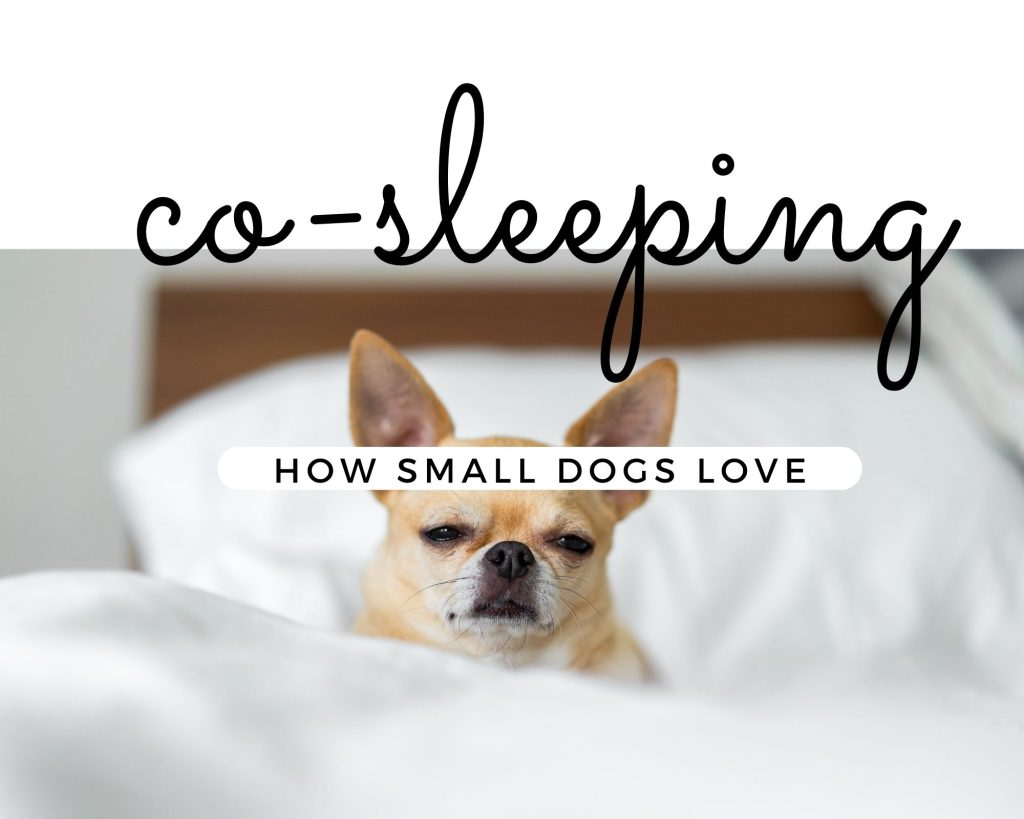 Dr. Arnett reports that dogs only sleep with beings they trust completely, and certainly the same can be said of humans. Thus, inviting your pup to sleep with you is perhaps the ultimate expression of love: it demonstrates to your dog that you have a deep faith in the relationship.
Dr. Arnett reports that dogs only sleep with beings they trust completely, and certainly the same can be said of humans. Thus, inviting your pup to sleep with you is perhaps the ultimate expression of love: it demonstrates to your dog that you have a deep faith in the relationship.
While a trusting relationship with your pup is vitally important, so is a good night’s sleep. For years, when our family included big golden retrievers, I adhered to a “no dogs in bed policy.” Our goldens not only took up too much room, they left behind too much fur. It just wasn’t comfortable for us, no matter how much we loved our big dogs. But Havanese are small and don’t shed, and so inviting them to sleep with us was an easy decision.
Initially, though, allowing the pups in bed didn’t really happen as a pure expression of our love for them.
Both my husband and I can be restless sleepers (such a lovely thing that happens as we humans age), and I’d read that co-sleeping with your dog actually improves insomnia. And it does! Just placing my hand on the girls in the middle of the night puts me right back to sleep. Now our shared bed policy is a given, and we all pile into bed at day’s end, cuddled in a protective family cocoon.
Phoebe and Scout love this co-sleeping time so much that Scout actually becomes mildly irritated if I attempt to stay up past nine o’clock, pawing at my arm to alert me as though I’m a poorly behaved child. When I say “bedtime!” they tear down the stairs and into our bedroom before I’ve barely stood up. When I’ve finally readied our home for the next day, washed my face, and headed for bed, they’re already there, waiting happily. As I settle in, they both rearrange themselves, each of them claiming a spot and leaning into my warmth.
Family sleep time has become a reassuring ritual that speaks to them–it’s a way to show your dog love in a language they understand.
We Hold Our Small Dogs’ Gaze
 Dr. Arnett’s next recommendation is that we spend time looking into our dog’s eyes.
Dr. Arnett’s next recommendation is that we spend time looking into our dog’s eyes.
Why gaze at your dog? Well, it’s one way they show love TO us, and when we reflect their actions, they feel our love back. Staring into your pup’s eyes creates a hormonal bond called an “oxytocin loop,” where each creature receives a repeating burst of that restorative feel-good hormone.
This oxytocin loop acts as a magic love potion, and it’s a specialty of human infants, who lock eyes with their mothers to activate floods of love. Puppies and small dogs manage to replicate this beautiful connection with their humans. If you’re interested in the science behind the love, we wrote about it in our article “Bonding With Your Small Dog”. And even if you’re not interested in the how, know that gazing into your small dog’s eyes is another way to show your dog love they understand.
We already spend considerable time staring into Phoebe and Scout’s eyes, and given their happy little demeanors when we do so, we know they must feel adored. In fact, my husband once looked at Scout and announced “your eyes are like beautiful brown glass marbles.” I tell him he’s never said anything half so romantic to me :).
Should We Lean On Our Small Dogs?
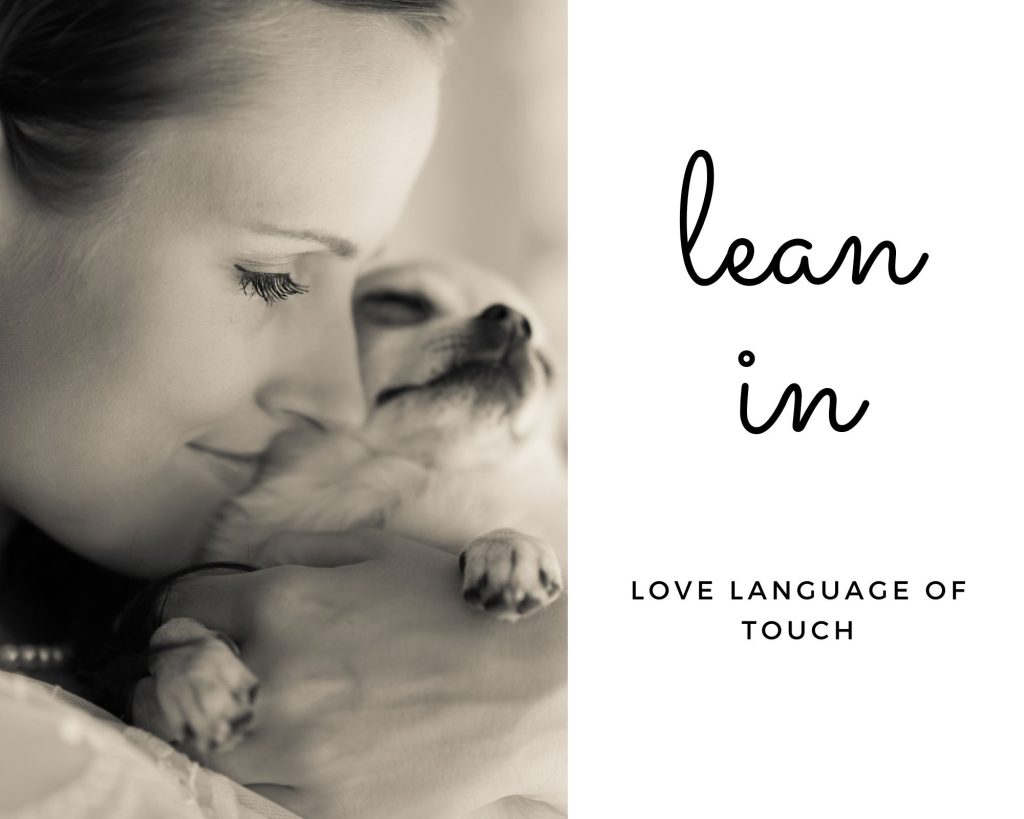 Next on Dr. Arnett’s list of “love in dog language” involves resting your weight (or at least some of it) against your pup.
Next on Dr. Arnett’s list of “love in dog language” involves resting your weight (or at least some of it) against your pup.
We admit we don’t do this, but maybe we should, as all our golden retrievers were big leaners. In fact, our late golden retriever Romeo’s favorite thing was to be leaning against one of us. All eighty-plus pounds of him. He loved hard.
When twelve-pound Phoebe and Scout lean against us, we barely notice. But the fact is, they ARE still leaning, which means they’re showing us love. Next time, I think I’ll return the connection a bit and see how they react. I have a feeling they’ll stare up at me and start that oxytocin loop.
And speaking of eyes, the last item on Dr. Arnett’s list of how dogs feel affection is much subtler, as it involves very small facial muscles connected to our eyebrows.
We’ve Never Raised An Eyebrow
At Our Small Dogs
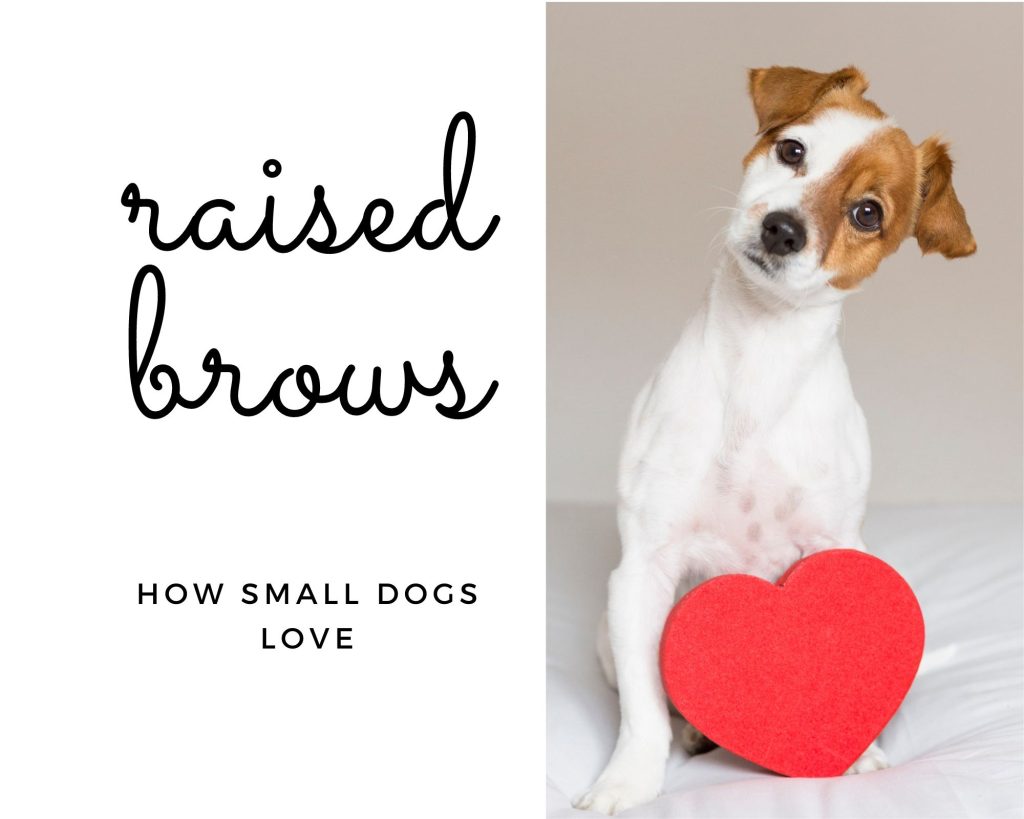 But we will. The left one, to be exact.
But we will. The left one, to be exact.
Several studies show that dogs consciously use their eyebrows to connect with us, and so it only makes sense that they would respond to their human family doing the same.
We’ll keep track of whether they react to it at all and report back.
From Dog Language to Love Language
I’m sure there are more ways to use your dog’s language to tell them you love them, but the methods listed above seem to be the most frequently mentioned. So now, let’s explore other ways small dog owners can make sure our dogs know we adore them. And in order to do that, we need to consider not just our dog’s language, but our dog’s love language.
What Is My Dog’s Love Language?
When researching how dogs experience love, I stumbled across searches from other besotted dog owners asking how do I show my dog I love her and am I showing my dog enough affection? Some people were even a bit worried about their overwhelming love for their dogs, asking why do I love my dog so much it hurts?
We feel those people. Heck, we ARE those people.
To answer these questions, let’s take a closer look at both the concept of love and how that concept impacts your individual dog. In addition to Dr. Arnett’s suggestions above (leaning, gazing, sleeping), what are other ways to show love to your dog? The answer may well be imbedded in your pup’s personality. Just as with humans, individual dogs likely have love languages.
In humans, the concept of love languages has been around for decades. Dr. Gary Chapman first coined the concept in his book The Five Love Languages. (Note: When you make a purchase using a link on this post about loving your small dog, we may receive a commission. Thank you for supporting The Small Dog Rules @ Downward Sizing Dog. As a Chewy Affiliate and an Amazon Associate, we earn from qualifying purchases. Our full disclosure, disclaimer, and copyright notices are found here. )
Although written in the ’90s, “love languages” became an integral part of how we think about love. Indeed, it’s morphed into a brand with special book versions for couples, singles, and parents. The idea is so ingrained in our view of love, that people readily refer not only to their own love language, but to the love language of everyone they know.
It’s a thing. And we think it ought to be a thing that includes our dogs as well.
According to Chapman, the human love languages are (1) words of affirmation, (2) gifts, (3) acts of service, (4) quality time, and (5) physical touch.
According to the AKC and other popular canine organizations, dogs share the same five love languages as humans.
Certainly, we could retrofit human love languages to fit our small dogs.
But should we?
We believe it might be more helpful (and more loving) to acknowledge that dogs experience the world much differently than do humans. And then to use those differences to provide precisely what they need in order to feel loved.
All dogs possess senses of smell and sound we cannot truly fathom, but we might be able to love them better if we reach out to them through those senses.
How Your Dog’s Super Senses May Influence Their Love Languages
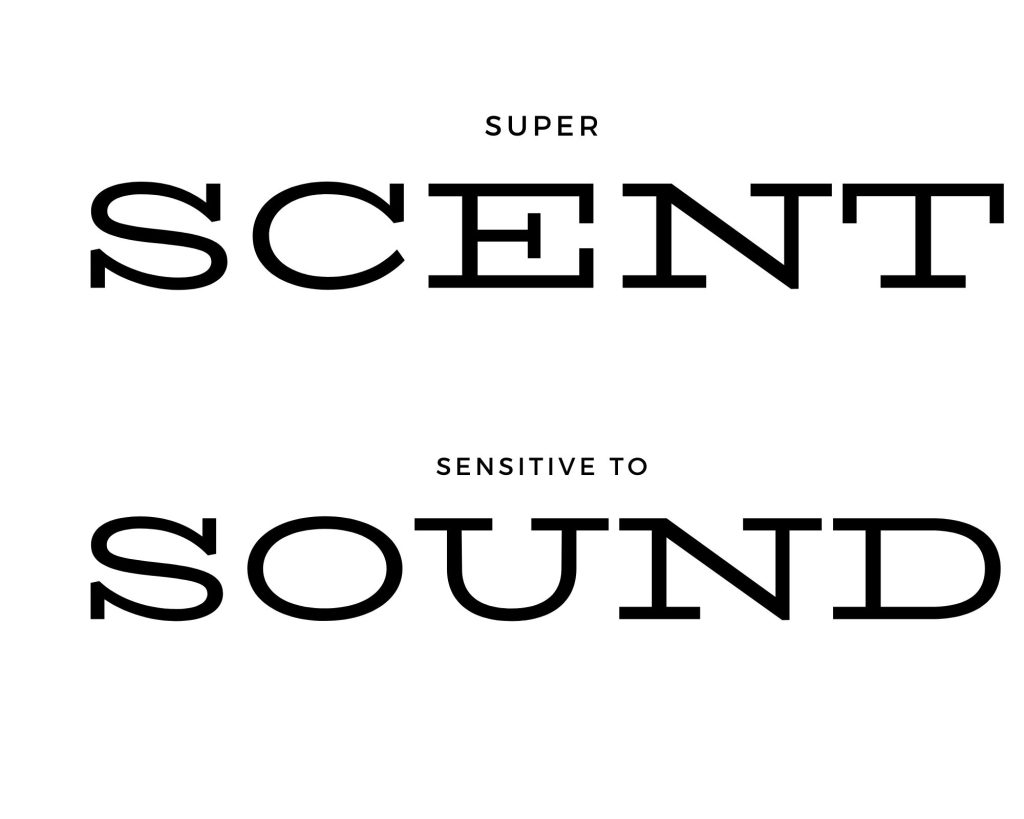 A dog’s sense of smell is at least 10,000 times more accurate than a human’s. To put it in context, we’ll look at a commonly-used example: a dog’s sense of smell is so sensitive he could detect a teaspoon of sugar in water equivalent to two Olympic-sized pools.
A dog’s sense of smell is at least 10,000 times more accurate than a human’s. To put it in context, we’ll look at a commonly-used example: a dog’s sense of smell is so sensitive he could detect a teaspoon of sugar in water equivalent to two Olympic-sized pools.
Similarly, a dog’s hearing, while not quite so super-charged as their sense of smell, is still about four times that of ours. What our pups can hear at forty feet, we have to be within ten feet to hear. In addition, remember that hearing is also about frequency, and dogs can not only hear further than we can, they can hear higher frequencies.
So, while it’s true that dogs and people may share common human love languages, it’s also likely accurate to say that dogs must have love languages directly related to their heightened senses.
As you’re discovering your small dog’s love languages, don’t forget to consider ways to activate or protect those amazing gifts of theirs.
The Love Languages of Small Dogs
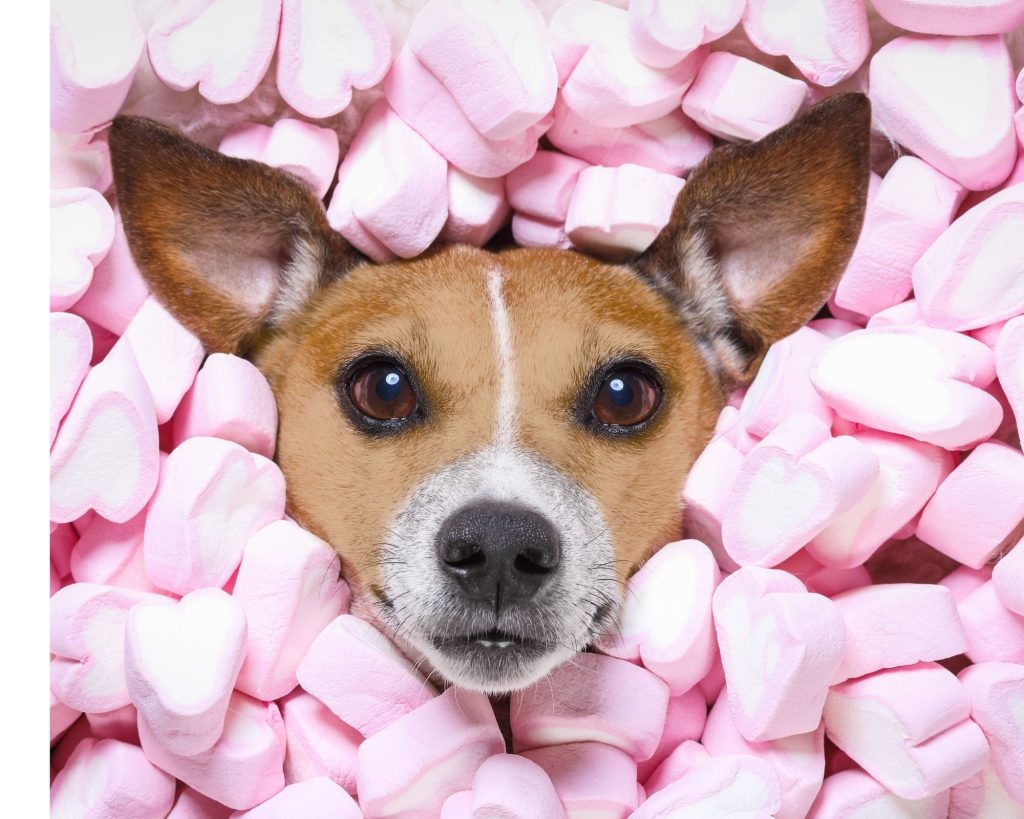 We know the human love languages are (1) words of affirmation, (2) gifts, (3) acts of service, (4) quality time, and (5) physical touch. And, we could all think of ways to give our dogs cliched fulfillment of the human love languages through enthusiastic praise, new toys, walks, play, and petting.
We know the human love languages are (1) words of affirmation, (2) gifts, (3) acts of service, (4) quality time, and (5) physical touch. And, we could all think of ways to give our dogs cliched fulfillment of the human love languages through enthusiastic praise, new toys, walks, play, and petting.
But we’re interested in giving our pups love in a way they’ll definitely understand, so why not create categories tailor-made to give our small pups joy? After polling some of our Instagram and Facebook dog friends, we discovered these general categories: sustenance, movement, intellectual engagement, touch, and social connection. If you have more, please let us know in the comments below!
Sustenance (Sharing healthy food)
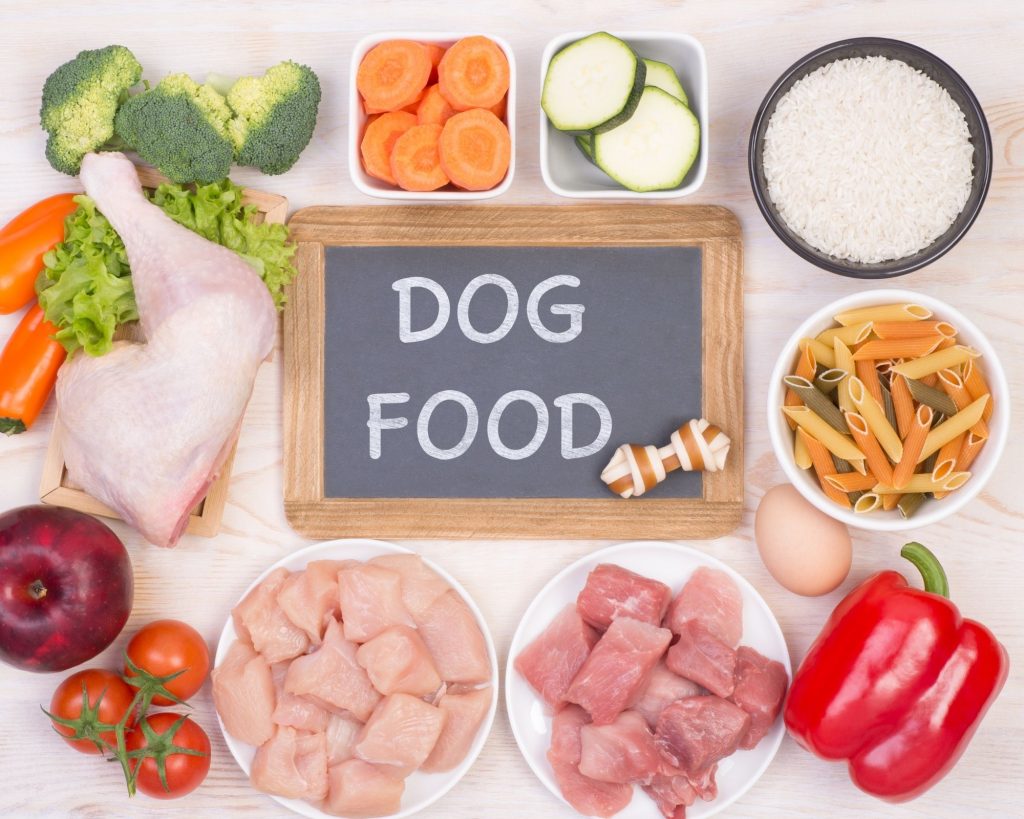
Not only is our small dog’s food key to their longevity and quality of life, but we know they dance with joy when we give them their favorites. For years, we’ve worked to find whole or real food treats the girls love. In this way, we show affection to them with food that’s also good for them. They both experience such giddiness when we share with them their favorites: bits of turkey, salmon, steak, and tuna, baby carrots and shredded cheddar cheese.
The best part of sharing these tidbits with our Havanese is the bonding we all enjoy as a result. Either we’re using these treats for games and teaching, or we keep a few pieces on the table during our dinner. They know they’re guaranteed to share either a bite of our meal or one of their treats, but only after we’re finished eating. Until then, they sit patiently with us.
They become part of our meals, as we are part of theirs.
Sharing Meals
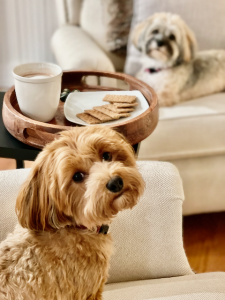
And that’s another way we use food to tell our small pups we love them. Our havies, like many small breed dogs, like to eat in the company of humans. I would imagine that’s especially true with an only dog.
I mean, while some of us say we’re perfectly at ease eating alone in a restaurant…are we really? If we were truly comfortable, we probably wouldn’t bother mentioning it!
We suspect that most small dogs also enjoy company when they eat, and we know that’s true of Scout. She’s a much slower eater than Phoebe, who inhales her food in under a minute. Scout can still be munching morsels five minutes later. And because she likes to take a bite and look around when she chews, swallows, and then takes another leisurely nibble, she’s very happy when there’s someone leaning against the island keeping her company.
If you think your small dog might have a love language connected to food, work with her to find the healthiest treats, and make mealtime a family time that includes her as well.
And, if you’d like to learn more about the connection between food and health, read our small dog nutrition article.
Movement (exercise, involvement)
While many small dogs need less intense and sustained exercise than big dogs, that fact doesn’t mean they’re happy with minimal movement. Nothing ages a dog (or a human) faster than lack of physical activity. Indeed, Veterinary Practice News reports on the likelihood that “increased physical exercise is beneficial in maintaining [a dog’s] health and slowing aging.”
But, we don’t need scientific studies to prove that dogs feel loved when we provide them with ample exercise and plenty of movement. When we become too busy in our home and skip walks or neglect to get the girls moving every hour in the same way we do for ourselves, they become bored and somewhat withdrawn. Phoebe and Scout are so well-behaved they’d never act out, but it’s almost that they become depressed. Thus, we know from experience that play and movement are essential to making a dog feel loved.
 Throughout the day, we take advantage of the fact that a Havanese is a velcro dog, following us wherever we go in the house. Instead of just silently moving from one household task to another and leaving the girls to follow, I invite them along as though laundry or bed-making or doing dishes is a great adventure.
Throughout the day, we take advantage of the fact that a Havanese is a velcro dog, following us wherever we go in the house. Instead of just silently moving from one household task to another and leaving the girls to follow, I invite them along as though laundry or bed-making or doing dishes is a great adventure.
In this way, our dogs know love because they feel included and important, doing work along side us
Touch (closeness, massage)
When we asked our Instagram and Facebook groups how their small dogs feel love, “physical touch” was one of the most popular responses.
As we noted above, dogs show love by leaning against their humans. So, it was pretty cool to see small dog owners echo that idea, saying things like their pup likes to “snuggle in and be close,” “he will snuggle while pressed up against us,” and he “positions himself as close as possible” even if it’s an uncomfortable position.
We’ve become more conscious of providing sustained, firm connection with Phoebe and Scout, and we’ve noticed they seem happier and more playful as a result. Like humans, dogs thrive when given a calming, physical laying on of hands.
Massage
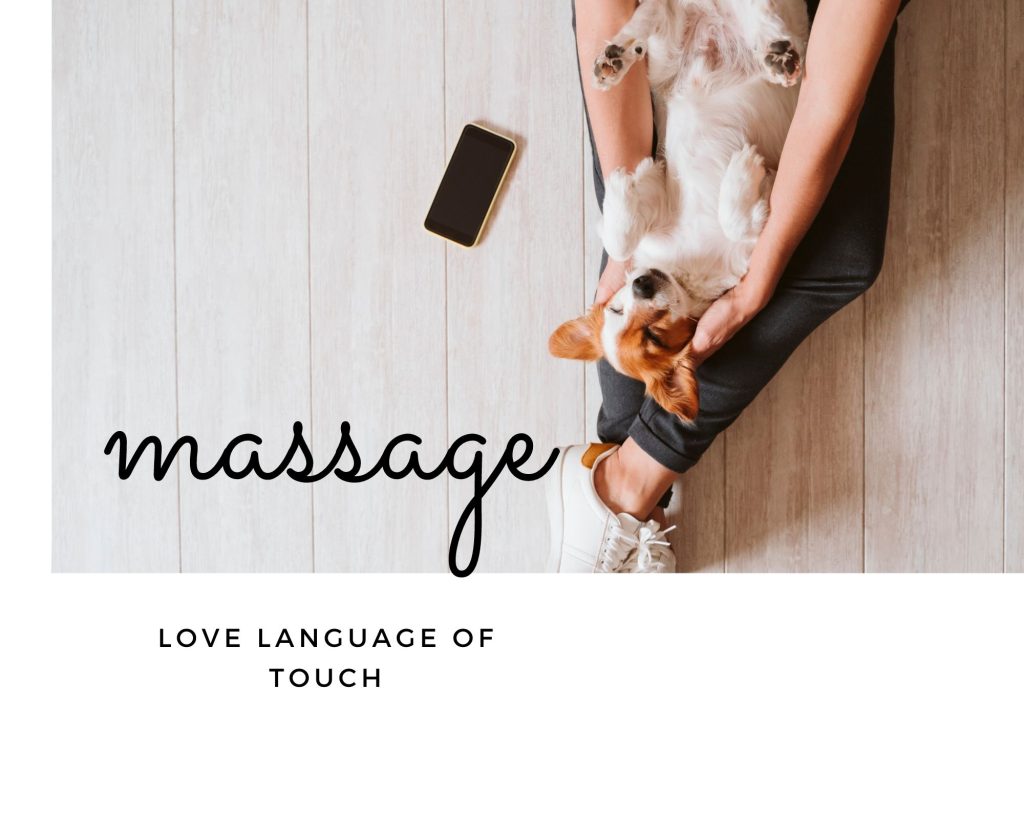 Perhaps the most purposeful form of touch is massage. And it’s a popular spa treatment for small dogs.
Perhaps the most purposeful form of touch is massage. And it’s a popular spa treatment for small dogs.
Most small dog owners mentioned massage and petting as their pup’s love language. Some dog moms shared recordings of their small dogs telling them how much they love a particularly skilled massage. Their dogs moan and actually purr with happiness when their masseuse hits just the right spot.
We loved the variety of massage too, with some dog moms sharing their method of facial and paw massage, Our own pup massages seem basic in comparison, and we need to up our game there.
Intellectual Engagement (puzzles, scent work, days that change)
While physical touch is vital to making our dogs feel cherished, acknowledging them as intelligent beings is just as crucial. As those of us with small dogs know well, one size does NOT fit all. Our small dogs have agile brains that crave stimulation as well.
Puzzles
Several times a week, we put our dogs’ meals into one of many dog puzzles they love. It’s amazing how excited they become when they can hunt for their food. (It makes me, who prefers my meals placed right in front of me at the table, no shopping, prepping, or cooking required, feel really lazy). Their smiles and wiggly butts make it clear they feel confident (and loved) when they solve the puzzle and rescue their food.
Scent Work
We’ve also begun playing around with scent work after listening to Why Is Your Dog’s Nose a Superpower on Dog Edition podcast. I quickly realized how much I’d neglected the scent aspect of Phoebe and Scout’s world when Scout initially just didn’t understand how to sniff out a treat hidden in the house.
Now that we’ve awakened that important part of her, she’s suddenly discovered an entirely new universe. She’ll come tearing out of a room at full speed, emerging victorious after finding a hidden toy or treat. My favorite part is afterward when she stands up and leans both her front paws on me, asking to be picked up. In those moments, I’m the one feeling the love.
Days That Change
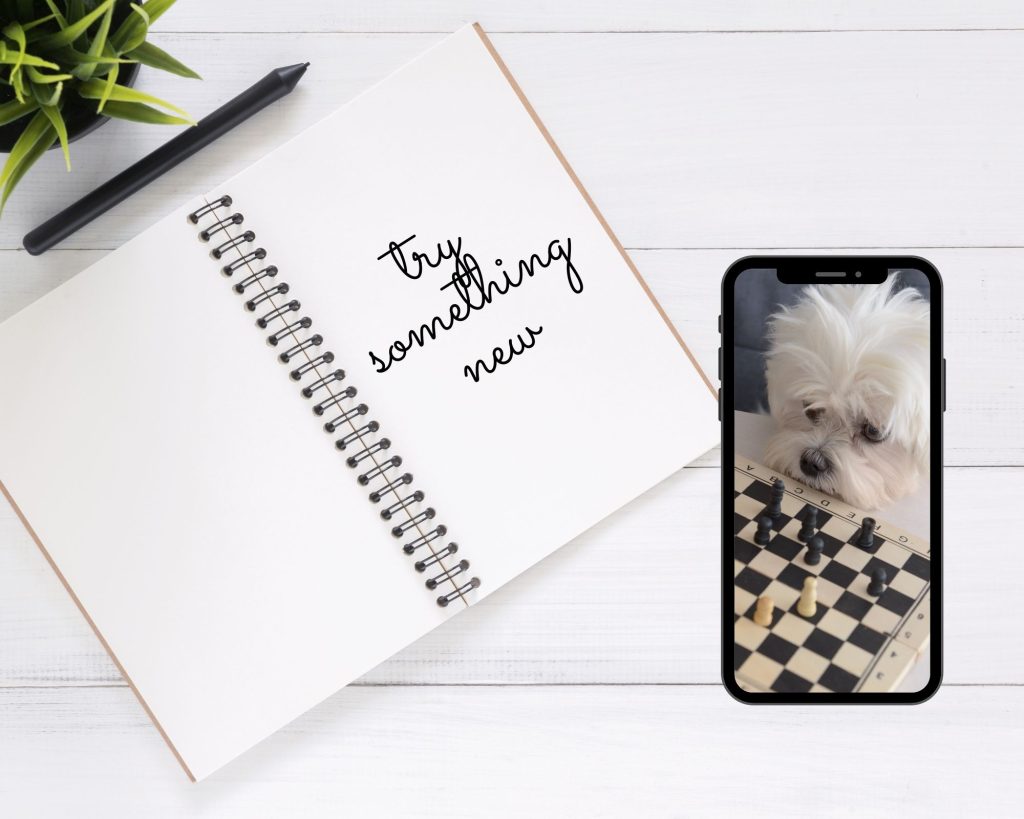 Helping our small dogs find new ways to enjoy their world through games fulfills the love language of intellectual engagement. And another aspect of engagement is ensuring their lives don’t become monotonous. (Chances are, you’ll find that in consciously changing up your small dog’s world, you’ll change up your own as well, in an incredibly satisfying way.)
Helping our small dogs find new ways to enjoy their world through games fulfills the love language of intellectual engagement. And another aspect of engagement is ensuring their lives don’t become monotonous. (Chances are, you’ll find that in consciously changing up your small dog’s world, you’ll change up your own as well, in an incredibly satisfying way.)
Of course, we acknowledge that when it comes to toddlers and small dogs, routine is important.
But sameness can be mind-numbing and deflating. It’s true in humans, and it’s probably more true with our dogs, who have such little control over their environment. So, one way we show our dogs love is by ensuring every day unfolds a bit differently. To switch things up, we
- let Phoebe and Scout choose our walking paths
- vary their treats
- change the place we do training sessions and mix the order of tricks we work on
- play impromptu hide and seek
- switch out their toys every week and move where their toy tent is located.
If you need additional ideas about how important it is to provide variation and intellectual engagement to help your small dog feel loved, you might want to read our article Play With Your Small Dog: It’s Essential for Their Mental Health
Social Connections
Out and About
Last, but of course not least, on our list of A Small Dog’s Love Languages is importance of social connections. Many of our Instagram friends commented they take their small dogs almost everywhere with them, and we certainly try to do the same.
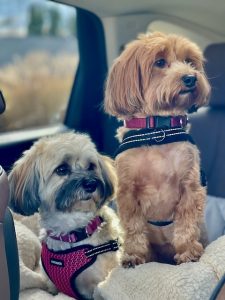 Bringing your dog with you on errands or visiting friends, when it’s safe to do so, opens up both their world and their personality. People comment on how friendly, calm and well-behaved Phoebe and Scout are, and they sometimes mistakenly think I’m some expert trainer.
Bringing your dog with you on errands or visiting friends, when it’s safe to do so, opens up both their world and their personality. People comment on how friendly, calm and well-behaved Phoebe and Scout are, and they sometimes mistakenly think I’m some expert trainer.
Trust me, I’m not. It’s just that when you take your pups along, they become more comfortable with new people and new things. (I’m not saying it’s always a non-event, and I’ve had plenty of embarrassing moments when, for example, Phoebe suddenly decides that she needs to bark at me in public with the same ferocity of Lassie announcing Timmy has fallen in the well. But, those moments end up being ideal training opportunities, where we reinforce our understanding of “quiet,” and all is soon right with the world).
Your small dog’s presence in stores, outdoor cafes, and friends’ homes helps them become deeply confident and comfortable in their own skin. And that is probably one of the best ways to show your dog love.
Dog Playmates
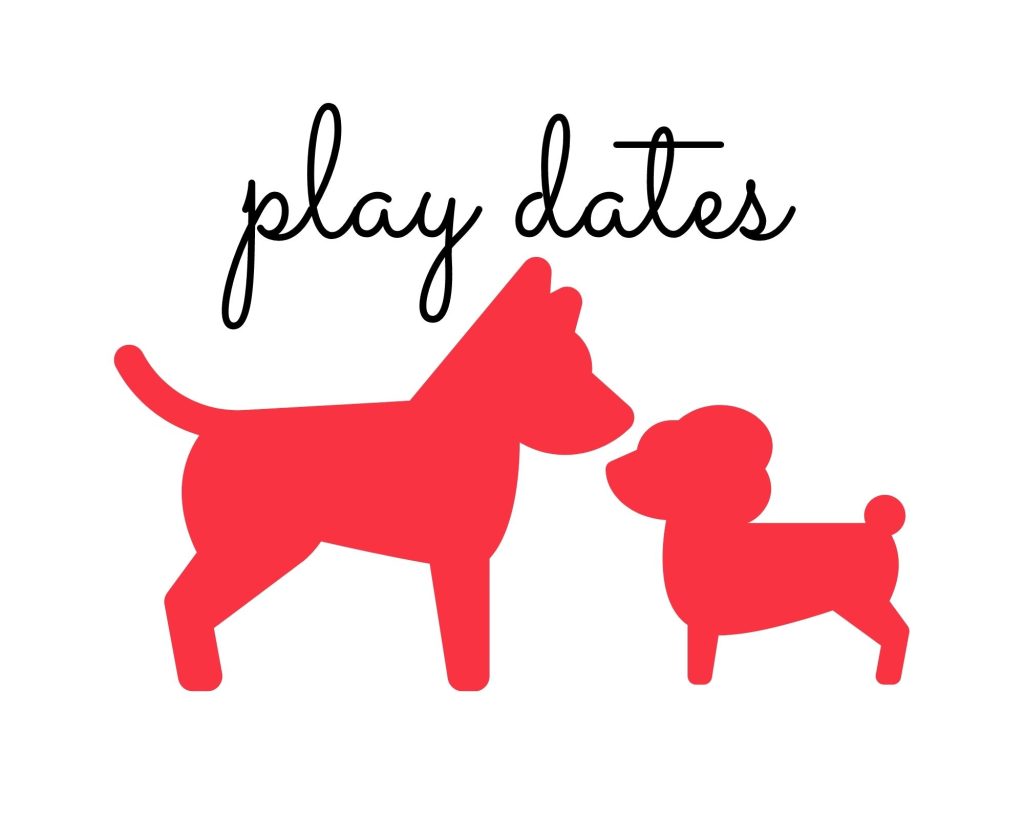 In addition to socializing with humans, dogs feel love when you provide them canine companionship. We’re very big fans of dogs having their own dog pack. But, we recognize that not everyone wants (or can have) a second dog. (If you’re considering the idea, be sure to take our Should I Get A Second Dog Quiz. )
In addition to socializing with humans, dogs feel love when you provide them canine companionship. We’re very big fans of dogs having their own dog pack. But, we recognize that not everyone wants (or can have) a second dog. (If you’re considering the idea, be sure to take our Should I Get A Second Dog Quiz. )
Having two dogs in the household IS more work and expense, but to us, it’s one way we provide a feeling of family for our small dogs. They’re like siblings, and they love and squabble with each other in much the same way as little kids do.
But for those who prefer an only-dog home, dog packs can easily be created outside the family, assuming your small dogs enjoy other dog company. (We admit that Phoebe and Scout are nicknamed “The Mean Girls” because they actually shun their visiting dog relatives. They truly don’t enjoy playing with other dogs–just with each other. It’s just not their love language.)
If, unlike my mean girls, your dog loves other dogs, you can schedule actual playdates either at home or a dog park, or you can ask your dog walker to let your pup walk with other trustworthy dogs. Perhaps the easiest solution to ensuring your pup has other dog playmates is by finding a doggy neighbor and offering to walk their dog at the same time. You’ll know pretty quickly if the two pups mesh, and eventually you can arrange some fun off-leash play.
Providing both human and canine social connections on a regular basis is a powerful way to show your small dog you love them.
Summary: How To Show Love
To Your Small Dog
Showing our small dogs love in a way they understand is actually pretty simple and costs very little. It’s all about paying attention to the way they love us, and mirroring that love in return. Beyond that, it’s about paying close attention to what makes them happy and figuring out their love languages.
We’ve condensed all our words above into an easy-reference graphic below. And, we wish you many happy years of showering love on your pups with language they understand.
How do you show your small dog love? Does she have one love language? We’d love to hear from you in the comments!
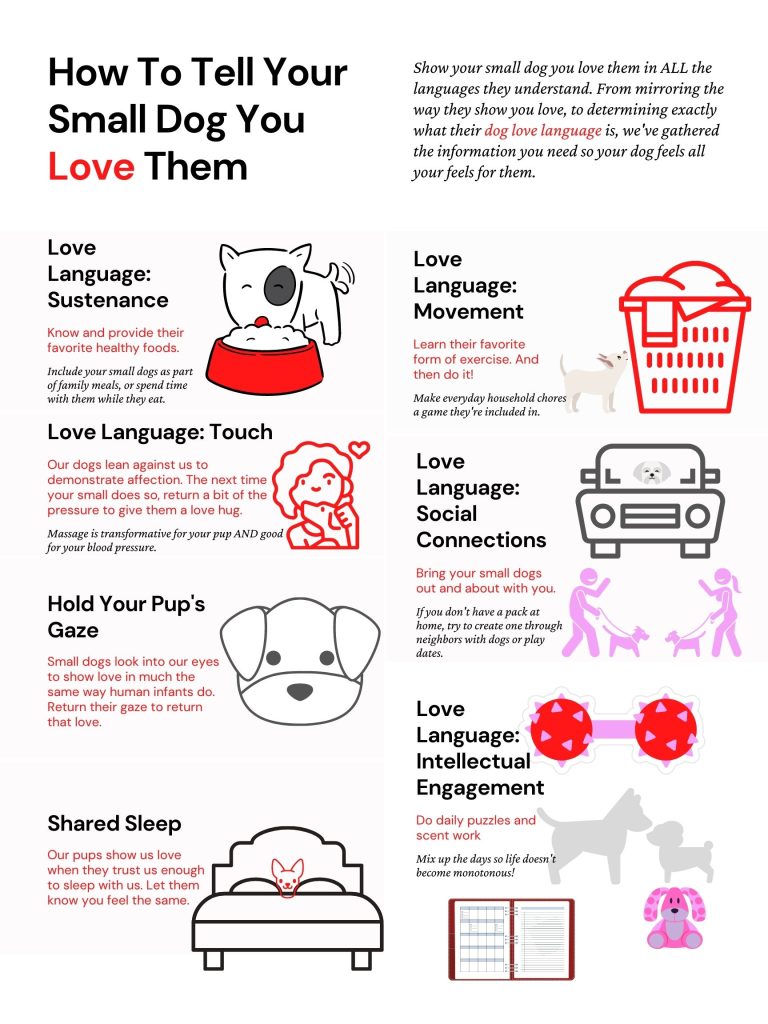
You’ll Also Love
Leave a Reply
Your email address will not be published.

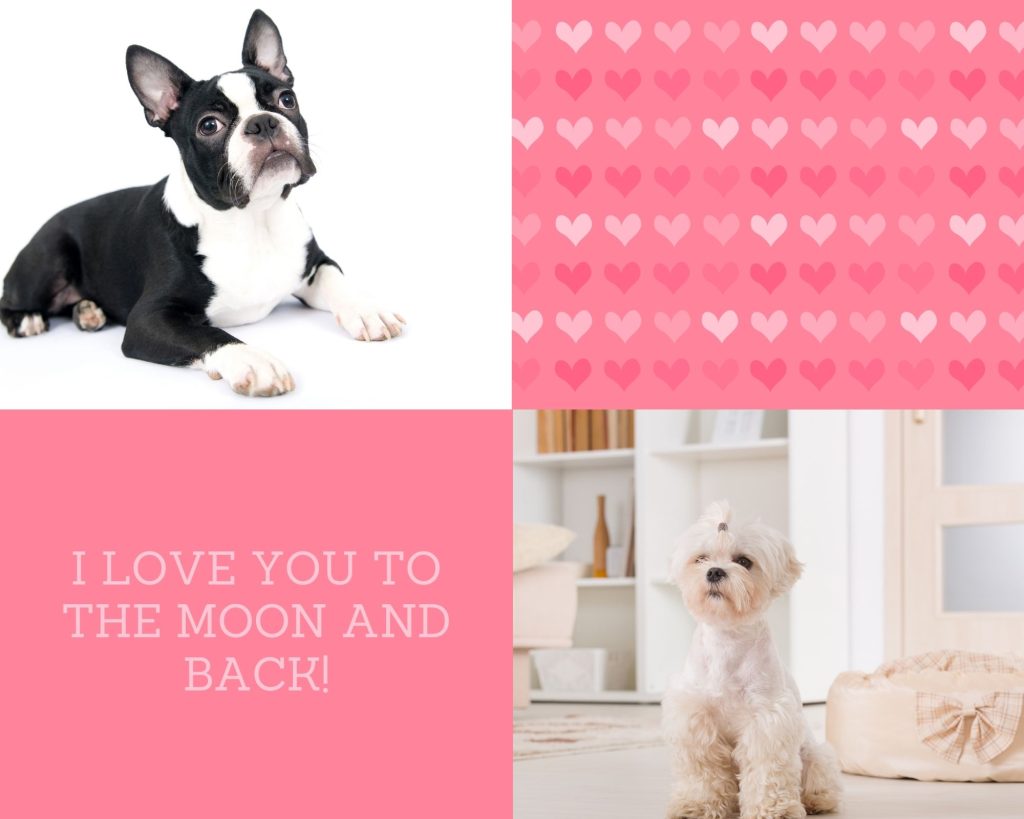





Wonderful article! Snuggling and sharing our bed are definitely ways we feel closer with our little guy. As for the other things mentioned, we’ve noticed a lot of these habits in our Havanese, but didn’t realize some of them are ways of showing love!
Hi Raja and Ankita: Thanks so very much for reading and for bringing up the Havanese connection. We felt pretty special when we learned that the deep eye gazing actually IS one way small dogs show love.It certainly feels that way, but it’s nice to see science confirming it :). Scout has it down pat, and I swear she has us wrapped around her paw as a result.
Great article. I realized that I’m not mixing things up enough for my boys. And that I only tap into some of their love languages and need to try some I’ve been missing.
Hi Jeanne – We really appreciate you stopping in to comment :). I hope we didn’t make you feel guilty at all, as that wasn’t the intention! You are such an amazing dog guardian. We’re like you – our research showed us some things we could add. The “scent work” is the thing that’s been the most fun. Thank you again for taking time on the website 💕.
Such a great article and reminder to mix things up! I love all of the different love languages you covered. Happy Valentine’s Day to you and the pups!
Thanks so much, Tiffany! Have so appreciated your great food content of late. The beet juice for natural red dye was just the info I needed 😊
Great article!….it really made me consider the ways I show my pup love in all the different categories. Thank You! My 9 month old havanese is a rescue and has only been with us for 2 months so we are still working on things, but she is showered with love through food, eye gazes, walks, sleeping together, and endless cuddles. She loves being held in my arms like a baby while I stroke her head and whisper how much she is loved and safe. Next best for her is when I give her soft belly rubs. She totally relaxes with her legs splayed in total surrender. And she even enjoys being brushed as I murmur how pretty she is. I am now aware, however, that I need to offer more intellectual challenges, so thanks for bringing that to my attention and for the link to ideas. 🐶
Always so happy to hear from you! You have one lucky puppy there – please let me know if you discover any particular brain games you like for her. I think Havanese are such a special breed (obviously :)) and while they don’t get destructive like other dogs do when they’re bored, I do see my pups have been so much more playful and happy since I’ve been working on their heads AND their hearts. 💕
Great articles with lots of tips. We find even with company, our Havis get bored. Love the puzzle feed toys.
Hi Elizabeth – thank you so much for reading and commenting 💕. We agree with you – those puzzle feed toys are great. And, since we’ve started doing some (very) amateur scent work, we hide their treats, which is a big hit too. They’re twice as excited when they find one. Give the pups a scritch from us –